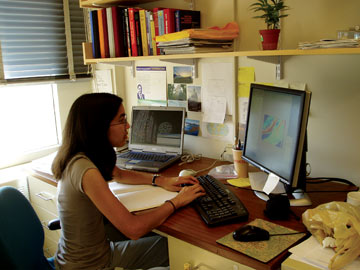|
NEWS NOTES
Earthquakes
Fore-arc basins May forecast earthquakes
 Courtesy of Andrea Llenos |
| Through theoretical analyses, Andrea Llenos and a colleague found further evidence that the slip in subduction zone earthquakes is larger beneath fore-arc basins than in locations without such basins. |
Subduction zones, where one tectonic plate slides beneath another, are geologic time bombs. Because extremely long fault lengths are possible along these areas, they produce the world’s largest earthquakes. However, the amount of movement in a given earthquake varies widely along a subduction zone, leading some earthquakes to stop abruptly while others continue and turn into large-magnitude events. Elucidating the reasons for this behavior would allow scientists to better evaluate the seismic hazard of particular locations.
One thought is that large slips occur beneath geological structures called fore-arc basins — places in active subduction zones where an overriding plate has subsided to form large depressions that fill with sediment. A new study published Sept. 6 in the Journal of Geophysical Research shows further evidence for this idea.
Andrea Llenos and Jeff McGuire of the Woods Hole Oceanographic Institution in Massachusetts gathered a dataset of 15 large earthquakes, such as the March 2005 magnitude-8.7 quake in Sumatra, and looked at the direction in which the individual ruptures propagated. By analyzing seismic data, the team found that most of the rupture paths, each between 40 kilometers and about 160 kilometers long, traveled through areas of low gravity, which are proxies for fore-arc basins, McGuire explains. Because these basins are filled with low-density sediments rather than solid rock, he says, they typically are less dense and cause the gravity field to be lower, so scientists can map them. The team compared the rupture areas to the gravity measurements above them and noted that 11 of the 15 earthquakes released the greatest amount of energy when they occurred in fore-arc basins. Moreover, the quakes stopped when the ruptures approached higher gravity areas outside the basins.
Scientists know from laboratory experiments that other factors, such as temperature and mineralogy, have a big effect on whether or not a particular segment of a fault can quake, McGuire says. “We know that there are certain types of rocks that are capable of having an earthquake and [certain types of] rocks that aren’t. We also know that some rocks start to slide past each other if they get too hot,” he says. “The reason why the correlation between the presence of fore-arc basins and the occurrence of slip is interesting is because it points to some other mechanism besides temperature and mineralogy.”
The findings call into question the long-held hypothesis that earthquake history influences whether specific areas of a fault are ready to rupture. If an earthquake propagates into a region that ruptured recently, there simply may not be enough stress remaining to allow another rupture soon, McGuire says. For example, researchers would not expect the southern portion of the Sumatra-Andaman Fault to quake again soon, because it released so much stress in the magnitude-9 earthquake in December 2004. However, fore-arc basins don’t form on the same timescale as earthquake cycles. While earthquakes occur every couple of hundred years, fore-arc basins take millions of years to form, says Mark Simons of Caltech in Pasadena, Calif. “You need almost a kilometer of topography to create the kind of gravity anomalies associated with fore-arc basins — and you don’t form a kilometer of topography in a couple of hundred years,” he says. This study suggests that fore-arc basins, rather than the amount of stress, determine the location where earthquakes release the largest amount of energy. The fact that Llenos and McGuire see a correlation between fore-arc basins and slip is “interesting,” Simons says. “If this hypothesis stands the test of time, it means that the location of large earthquakes in subduction zones is fixed over million-year-time scales.”
The mechanism by which fore-arc basins cause large slip is so far unclear, McGuire says. “At this point it’s just a correlation between the two,” meaning that researchers see larger slip at the same locations as fore-arc basins than in locations without such basins, he says. “But, if the presence of fore-arc basins tells you where the slip is going to be biggest in the next magnitude-8 earthquake, then you can make predictions as to which areas face the biggest hazards.” For example, some parts of the Cascadia subduction zone in Oregon and Washington are close to fore-arc basins while other parts are not. “That doesn’t mean that those locations that are far away from the basins are out of the woods,” he adds.

 Subscribe
Subscribe


